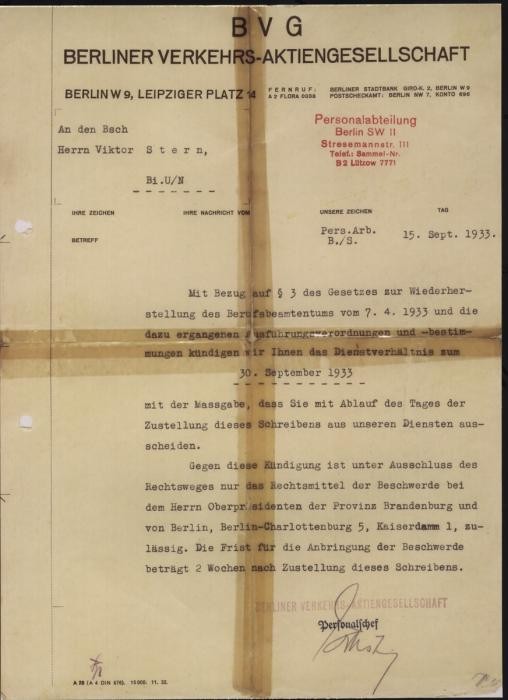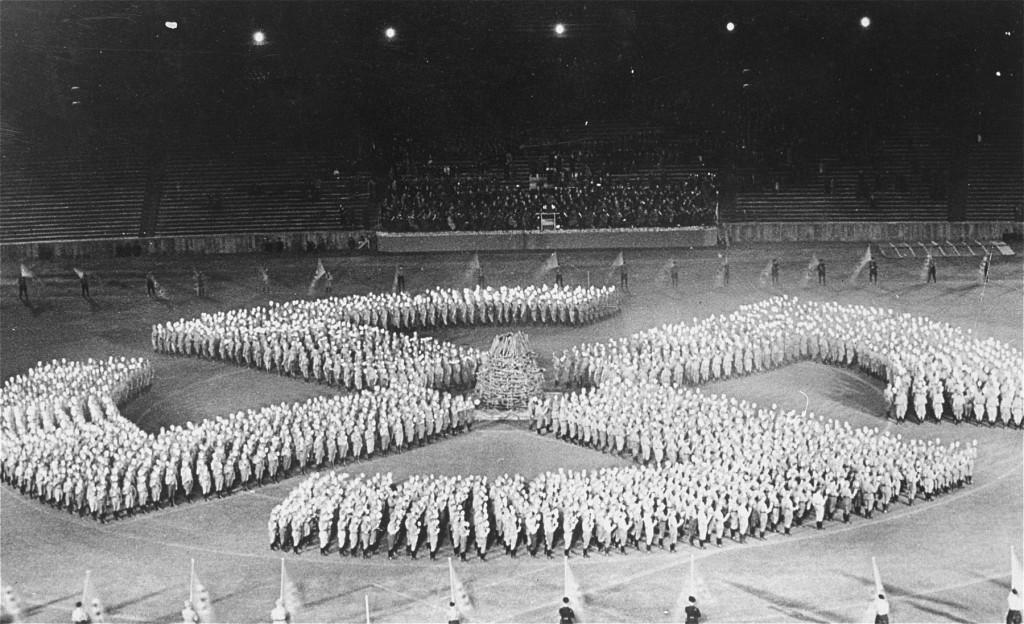
Gleichschaltung: Coordinating the Nazi State
The Nazi Party came to power in 1933 and quickly began trying to control all aspects of society. This internal consolidation of power to remake Germany as a Nazi state was known as Gleichschaltung. The term is a German word that means “coordination” or “synchronization.” Under Gleichschaltung, German political, social, and cultural life were rearranged to serve Nazi goals.
Key Facts
-
1
Gleichschaltung is a German word that means “coordination” or “synchronization.”
-
2
Gleichschaltung refers to a process of Nazification designed to turn Germany into a single party state under Hitler and the Nazi Party.
-
3
Even children were brought into the Nazification process. Participation in the Hitler Youth (Hitlerjugend) and League of German Girls (Bund Deutscher Mädel) became mandatory.
Background
Gleichschaltung is the German term applied to the Nazification of German society following the Nazi seizure of power in 1933. Once Hitler became chancellor, he and the Nazi Party sought to “coordinate” all political, social, and cultural institutions with the Nazi state. This “coordination” was done in the name of national unity. However, it allowed the Nazi Party to extend its power by creating a single party state. Everything was subject to coordination: local government, professional organizations, social clubs, leisure activities—even those for children.
The state enforced coordination from the top-down. At the same time, many Germans responded with a bottom-up coordination of their own. This was known as Selbstgleichschaltung. Even Hitler was surprised with the speed and ease of remaking Germany. He noted “everything is going much faster than we ever dared to hope.”
Creating a Single Party State
One of the primary goals of coordination was the creation of a single party state entirely under Nazi control. In January 1933, Hitler became chancellor. At the time, Germany was still a multi-party state. The country was led by a popularly elected representative government. The following month, the Reichstag (German parliament building) burned down by arson. The Nazis seized the chance to act. They blamed the Communist Party. On February 28, 1933, they issued the Reichstag Fire Decree. The measure suspended the protections for civil rights, free speech, and due process in the German Constitution.

On March 24, 1933, Hitler succeeded in passing the Enabling Act. The act gave the Reich Chancellor (Hitler) the ability to pass laws without consulting the Reichstag. He was able to do so even if those laws conflicted with the German Constitution. This effort effectively ended parliamentary democracy in Germany.
Hitler had succeeded in securing control of the national government. He passed two additional laws to reconstitute state-level governments under Nazi control. These laws dissolved existing state governments. The law also appointed a Reichsstatthalter (Reich governor) for each state. The Reichsstatthalter reported directly to Wilhelm Frick, the Reich Minister of the Interior. Each was responsible for implementing Nazi policy within their state.
The next target in this process was the civil service. Hitler issued the Law for the Restoration of the Professional Civil Service on April 7, 1933. The measure dismissed all Jews and political opponents of Nazis from the civil service. It covered every employee at every level of government administration. Further, it applied to numerous other positions not considered part of the civil service in many countries. For example, it covered judges, teachers, university professors, and lawyers. Many people, especially Jews and Communists, lost their jobs and retirement benefits. Many other people rushed to join the Nazi Party in order to protect their jobs in a time of high unemployment. All those who joined were not necessarily doing so from political conviction.
Hitler had gained control of the national and local governments. He had also secured a government workforce purged of all potential opposition. The Nazi Party could now declare Germany a single party state. On July 14, 1933, the party issued The Law Against the Founding of New Parties. It declared, “The National Socialist German Workers Party is the only political party in Germany.” Membership in other political parties, such as the Social Democratic Party or the Communist Party, became illegal. Members of these parties were targeted by the Nazis. Some fled the country or went underground. Within six months, Hitler and the Nazi Party had managed to gain complete control over the German state. They had eliminated all formal political opposition.
Coordinating Economic, Social, and Cultural Life
Absolute political power was not enough. The Nazi Party sought complete control over economic, social, and cultural life in Germany as well. All labor unions were abolished in May 1933, replaced by the Deutsche Arbeitsfront (DAF, or German Labor Front). The DAF created a single overarching labor union. Essentially all German workers and employees in every economic sector belonged to the DAF. For example, farmers were coordinated into the Reich Food Estate. While traditional unions prioritized workers’ rights, the DAF emphasized national economic goals above personal well-being.

In September 1933, Nazi Propaganda Minister Joseph Goebbels created the Reich Culture Chamber. It coordinated literature, music, theater, radio, film, fine arts, and the press. Only artists and writers belonging to its affiliated bodies could continue in their professions. Groups that were previously organized under political parties or labor unions—such as sports teams, music groups, and craft associations—were disbanded. The ones that remained were organized under the Nazi Party. Scouting organizations for children were also Nazified. A 1934 law made the Hitler Youth the only legal youth group in Germany. In 1939, participation became mandatory. All German children became exposed to Nazi ideology from an early age.
Even leisure time was coordinated according to Nazi principles in the Strength through Joy (Kraft durch Freude) program. The program was a division of the German Labor Front. Strength through Joy offered subsidized tourism packages, music lessons, art classes, fitness opportunities, and sponsored theater and concert tickets.
Conclusion
Gleichschaltung was a process of coordination. It was designed to bring all aspects of German life under Nazi control. From the single party state to the German Labor Front to the Nazi-approved leisure activities offered by Strength through Joy, almost no part of German life remained untouched by Nazism.
Footnotes
-
Footnote reference1.
Peter Fritzsche, Life and Death in the Third Reich (Cambridge, MA: Harvard University Press, 2008), 50.
-
Footnote reference2.
German Historical Institute, "Decree of the Reich President for the Protection of the People and State (“Reichstag Fire Decree”), February 28, 1933," Accessed January 23, 2020, http://ghdi.ghi-dc.org/sub_document.cfm?document_id=2325. An edited translation of the original text is available through the site, as originally translated from German and published by the United States Government.
-
Footnote reference3.
German Historical Institute, "The Enabling Act (March 24, 1933)" Accessed January 23, 2020, http://ghdi.ghi-dc.org/sub_document.cfm?document_id=1496. An edited translation of the original text is available through the site, as originally translated from German and published by the US Department of State, Division of European Affairs.
-
Footnote reference4.
Statement declared in Article 1 of The Law Against the Founding of New Parties, July 14, 1933.
-
Footnote reference5.
German Historical Institute, "Law on the Hitler Youth (December 1, 1936)" Accessed January 23, 2020, http://ghdi.ghi-dc.org/sub_document.cfm?document_id=1564. An edited translation of the original text is available through the site, as originally translated from German and published by the United States Government.
Critical Thinking Questions
How can knowledge of the events in Germany and Europe before the Nazis came to power help citizens today respond to threats of genocide and mass atrocity in the world?
Explore the pressures individuals felt under the Nazi regime, the range of decisions individuals made in the face of those pressures, and the relevance of this history now.

